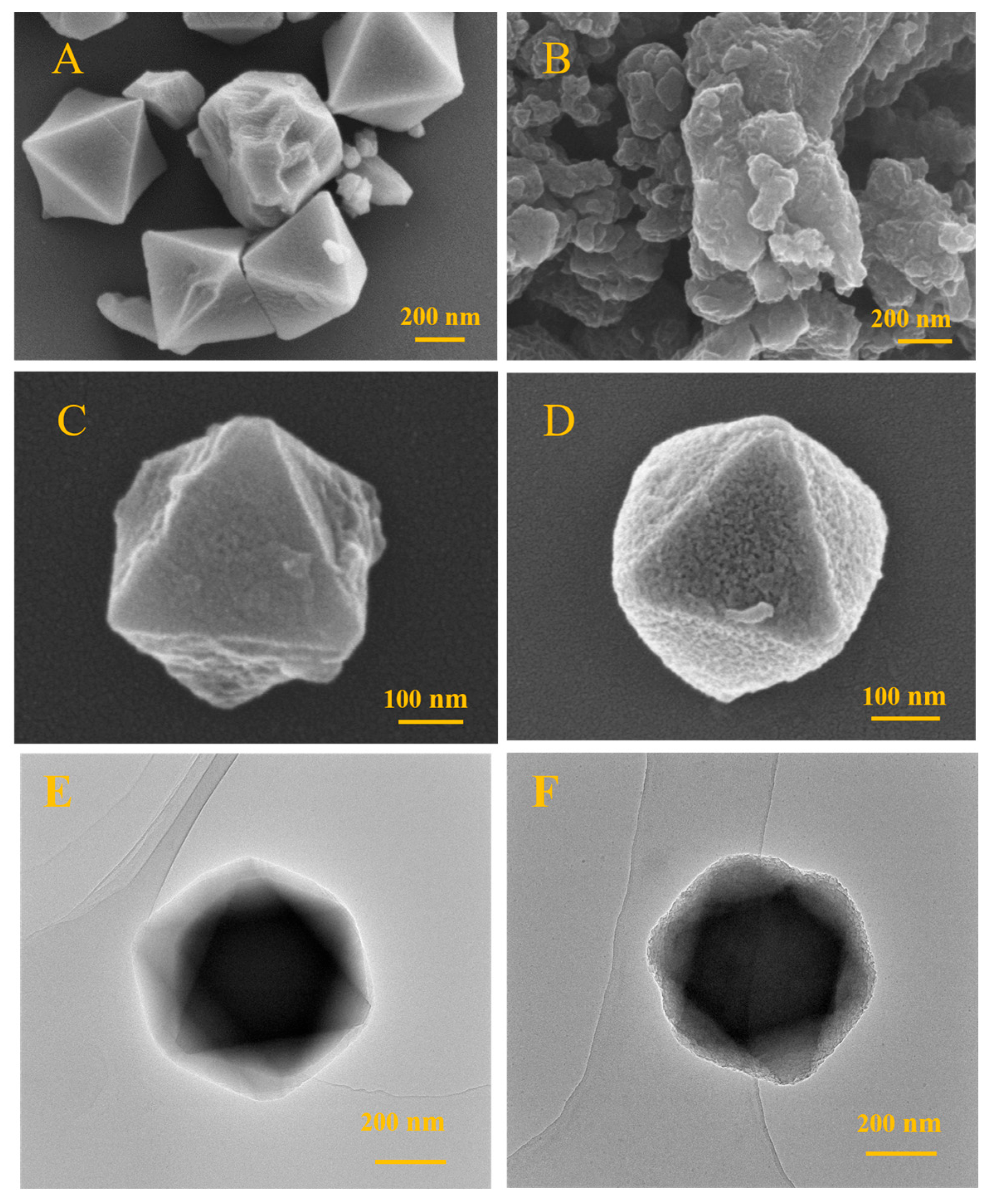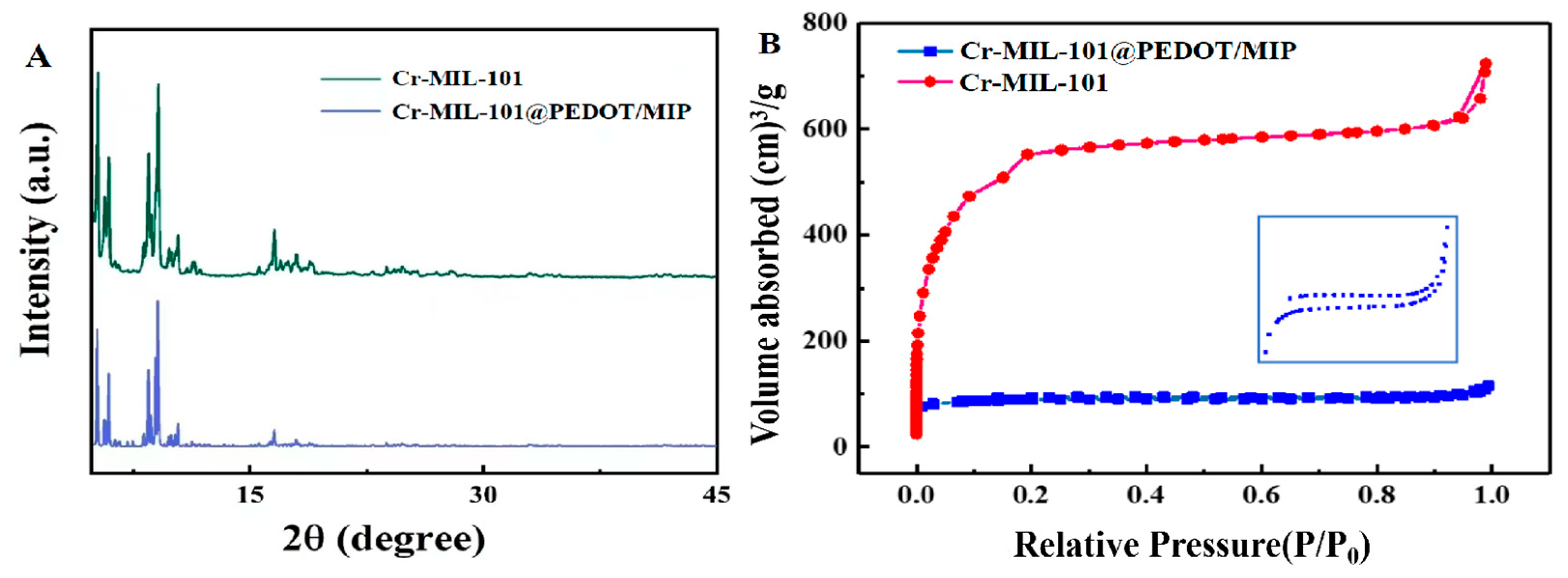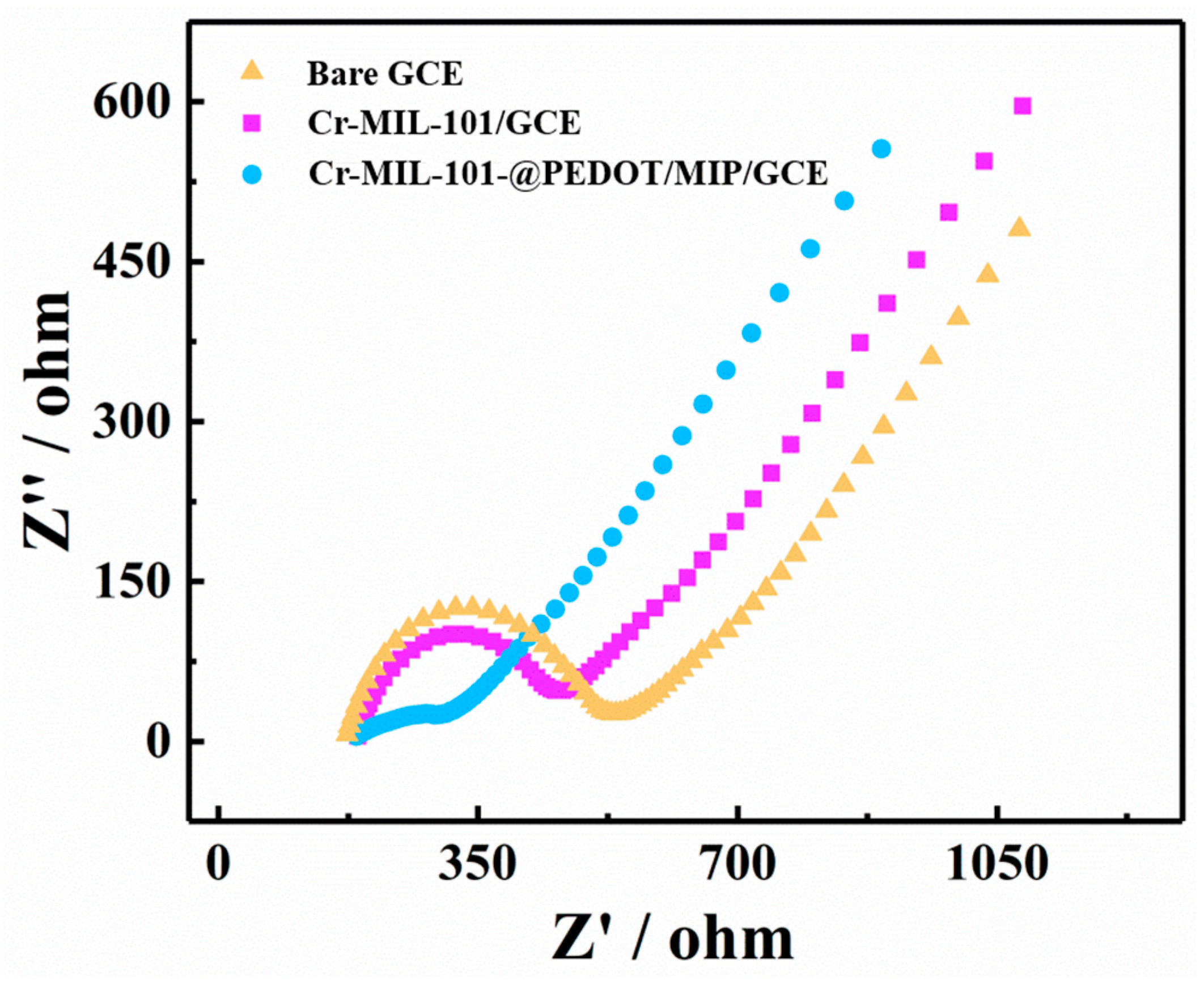Construction of Cr-MIL-101@PEDOT/MIP Composite Functionalized Glassy Carbon Electrode for PFOS Electrochemical Detection
Abstract
1. Introduction
2. Materials and Methods
2.1. Synthesis of Cr-MIL-101
2.2. Synthesis of Cr-MIL-101@PEDOT/MIP
2.3. Preparation of Cr-MIL-101@PEDOT/MIP/GCE
3. Results and Discussion
3.1. Structures and Properties of Cr-MIL-101@PEDOT/MIP
3.1.1. Morphology
3.1.2. XRD Analysis
3.1.3. Porous Network Structure Analysis
3.1.4. Surface Chemical Composition Analysis
3.2. Electrochemical Detection Performances of PFOS by Cr-MIL-101@PEDOT/MIP/GCE
3.2.1. Electrochemical Impedance Spectroscopy (EIS)
3.2.2. Quantitative Detection
3.2.3. Reproducibility, Stability, and Selectivity
3.2.4. Real Sample Detection
4. Conclusions and Outlook
Supplementary Materials
Author Contributions
Funding
Institutional Review Board Statement
Informed Consent Statement
Data Availability Statement
Acknowledgments
Conflicts of Interest
References
- Arias Espana, V.A.; Mallavarapu, M.; Naidu, R. Treatment technologies for aqueous perfluorooctanesulfonate (PFOS) and perfluorooctanoate (PFOA): A critical review with an emphasis on field testing. Environ. Technol. Innov. 2015, 4, 168–181. [Google Scholar] [CrossRef]
- Radetić, L.; Plantak, L.; Loborec, J.; Grčić, I. Super-resistance of PFOS in water: Is it beatable? Chemosphere 2024, 362, 142922. [Google Scholar] [CrossRef]
- Mao, W.; Li, M.; Xue, X.Y.; Cao, W.; Wang, X.F.; Xu, F.L.; Jiang, W. Bioaccumulation and toxicity of perfluorooctanoic acid and perfluorooctane sulfonate in marine algae Chlorella sp. Sci. Total Environ. 2023, 870, 161882. [Google Scholar] [CrossRef] [PubMed]
- Vierke, L.; Berger, U.; Cousins, I.T. Estimation of the acid dissociation constant of perfluoroalkyl carboxylic acids through an experimental investigation of their water-to-air transport. Environ. Sci. Technol. 2013, 47, 11032–11039. [Google Scholar] [CrossRef]
- Sungur, Ş. Dietary exposure to perfluorooctanoic acid (PFOA) and perfluorooctane sulfonic acid (PFOS): A review of recent literature. Toxin Rev. 2017, 37, 106–116. [Google Scholar] [CrossRef]
- Nguyen, G.T.H.; Nocentini, A.; Angeli, A.; Gratteri, P.; Supuran, C.T.; Donald, W.A. Perfluoroalkyl substances of significant environmental concern can strongly inhibit human carbonic anhydrase isozymes. Anal. Chem. 2020, 92, 4614–4622. [Google Scholar] [CrossRef]
- van der Veen, I.; Fiedler, H.; de Boer, J. Assessment of the per- and polyfluoroalkyl substances analysis under the Stockholm Convention—2018/2019. Chemosphere 2022, 313, 137549. [Google Scholar] [CrossRef] [PubMed]
- Heo, D.-G.; Lee, D.-C.; Kwon, Y.-M.; Seol, M.-J.; Moon, J.S.; Chung, S.M.; Kim, J.-H. Simultaneous determination of perfluorooctanoic acid and perfluorooctanesulfonic acid in Korean sera using LC-MS/MS. J. Chromatogr. B 2022, 1192, 123138. [Google Scholar] [CrossRef]
- Inoue, K.; Okada, F.; Ito, R.; Kawaguchi, M.; Okanouchi, N.; Nakazawa, H. Determination of perfluorooctane sulfonate, perfluorooctanoate and perfluorooctane sulfonylamide in human plasma by column-switching liquid chromatography-electrospray mass spectrometry coupled with solid-phase extraction. J. Chromatogr. B 2004, 810, 49–56. [Google Scholar] [CrossRef]
- Clark, R.B.; Dick, J.E. Electrochemical sensing of perfluorooctanesulfonate (PFOS) using ambient oxygen in river water. ACS Sens. 2020, 5, 3591–3598. [Google Scholar] [CrossRef]
- Liu, T.; Sun, B.; Sang, C.Y.; Cai, H.; Liu, H.; Liu, Y.W.; He, G.S. Rapid detection of perfluorodecanoic acid and perfluorooctanesulfonic acid in foods using a molecularly imprinted poly(o-phenylenediamine)/modified glassy carbon electrode. J. Agric. Food Chem. 2025, 73, 8073–8083. [Google Scholar] [CrossRef]
- Zhao, C.W.; Xu, Y.; Xiao, F.; Ma, J.; Zou, Y.B.; Tang, W.J. Perfluorooctane sulfonate removal by metal-organic frameworks (MOFs): Insights into the effect and mechanism of metal nodes and organic ligands. Chem. Eng. J. 2021, 406, 126852. [Google Scholar] [CrossRef]
- Ruan, X.F.; Liu, D.; Niu, X.H.; Wang, Y.J.; Simpson, C.D.; Cheng, N.; Du, D.; Lin, Y.H. 2D graphene oxide/Fe-MOF nanozyme nest with superior peroxidase-like activity and its application for detection of woodsmoke exposure biomarker. Anal. Chem. 2019, 91, 13847–13854. [Google Scholar] [CrossRef] [PubMed]
- Zhang, Y.P.; Zheng, X.J.; Guo, X.M.; Zhang, J.H.; Yuan, A.H.; Du, Y.K.; Gao, F. Design of modified MOFs electrocatalysts for water splitting: High current density operation and long-term stability. Appl. Catal. B-Environ. 2023, 336, 122891. [Google Scholar] [CrossRef]
- Karbassiyazdi, E.; Kasula, M.; Modak, S.; Pala, J.; Kalantari, M.; Altaee, A.; Esfahani, M.R.; Razmjou, A. A juxtaposed review on adsorptive removal of PFAS by metal-organic frameworks (MOFs) with carbon-based materials, ion exchange resins, and polymer adsorbents. Chemosphere 2023, 311, 136933. [Google Scholar] [CrossRef] [PubMed]
- Li, K.; Lin, S.L.; Li, Y.S.; Zhuang, Q.X.; Gu, J.L. Aqueous-phase synthesis of mesoporous Zr-based MOFs templated by amphoteric surfactants. Angew. Chem. Int. Ed. 2018, 57, 3439–3443. [Google Scholar] [CrossRef]
- Yu, C.; Bourrelly, S.; Martineau, C.; Saidi, F.; Bloch, E.; Lavrard, H.; Taulelle, F.; Horcajada, P.; Serre, C.; Llewellyn, P.L.; et al. Functionalization of Zr-based MOFs with alkyl and perfluoroalkyl groups: The effect on the water sorption behavior. Dalton Trans. 2015, 44, 19687–19692. [Google Scholar] [CrossRef]
- Cheng, Y.H.; Barpaga, D.; Soltis, J.A.; Shutthanandan, V.; Kargupta, R.; Han, K.S.; McGrail, B.P.; Motkuri, R.K.; Basuray, S.; Chatterjee, S. Metal-organic framework-based microfluidic impedance sensor platform for ultrasensitive detection of perfluorooctanesulfonate. ACS Appl. Mater. Interfaces 2020, 12, 10503–10514. [Google Scholar] [CrossRef]
- Barpaga, D.; Zheng, J.; Han, K.S.; Soltis, J.A.; Shutthanandan, V.; Basuray, S.; McGrail, B.P.; Chatterjee, S.; Motkuri, R.K. Probing the sorption of perfluorooctanesulfonate using mesoporous metal–organic frameworks from aqueous solutions. Inorg. Chem. 2019, 58, 8339–8346. [Google Scholar] [CrossRef]
- Darwish, M.A.; Abd-Elaziem, W.; Elsheikh, A.; Zayed, A.A. Advancements in nanomaterials for nanosensors: A comprehensive review. Nanoscale Adv. 2024, 6, 4015–4046. [Google Scholar] [CrossRef]
- Meer, S.; Kausar, A.; Iqbal, T. Trends in Conducting polymer and hybrids of conducting polymer/carbon nanotube: A review. Polym.-Plast. Technol. Eng. 2016, 55, 1416–1440. [Google Scholar] [CrossRef]
- Basak, S.; Venkatram, R.; Singhal, R.S. Recent advances in the application of molecularly imprinted polymers (MIPs) in food analysis. Food Control 2022, 139, 109074. [Google Scholar] [CrossRef]
- Pierpaoli, M.; Szopińska, M.; Olejnik, A.; Ryl, J.; Fudala-Ksiażek, S.; Łuczkiewicz, A.; Bogdanowicz, R. Engineering boron and nitrogen codoped carbon nanoarchitectures to tailor molecularly imprinted polymers for PFOS determination. J. Hazard. Mater. 2023, 458, 131873. [Google Scholar] [CrossRef]
- Lahcen, A.A.; Surya, S.G.; Beduk, T.; Vijjapu, M.T.; Lamaoui, A.; Durmus, C.; Timur, S.; Shekhah, O.; Mani, V.; Amine, A.; et al. Metal-organic frameworks meet molecularly imprinted polymers: Insights and prospects for sensor applications. ACS Appl. Mater. Interfaces 2022, 14, 49399–49424. [Google Scholar] [CrossRef]
- Hou, P.C.; Xing, G.J.; Han, D.; Zhao, Y.; Zhang, G.; Wang, H.; Zhao, C.; Yu, C.N. MIL-101(Cr)/graphene hybrid aerogel used as a highly effective adsorbent for wastewater purification. J. Porous Mater. 2019, 26, 1607–1618. [Google Scholar] [CrossRef]
- Huang, T.Y.; Kung, C.W.; Liao, Y.T.; Kao, S.Y.; Cheng, M.; Chang, T.H.; Henzie, J.; Alamri, H.R.; Alothman, Z.A.; Yamauchi, Y.; et al. Enhanced charge collection in MOF-525-PEDOT nanotube composites enable highly sensitive biosensing. Adv. Sci. 2017, 4, 1700261. [Google Scholar] [CrossRef]
- Guo, W.J.; Jing, Z.W.; Du, Q.Z. Research progress of metal–organic frameworks-molecularly imprinted polymers for specific recognition. Microchem. J. 2023, 191, 108908. [Google Scholar] [CrossRef]
- Karimian, N.; Stortini, A.M.; Moretto, L.M.; Costantino, C.; Bogialli, S.; Ugo, P. Electrochemosensor for trace analysis of perfluorooctanesulfonate in water based on a molecularly imprinted poly(o-phenylenediamine) polymer. ACS Sens. 2018, 3, 1291–1298. [Google Scholar] [CrossRef]
- Zhou, X.; Huang, W.Y.; Shi, J.; Zhao, Z.X.; Xia, Q.B.; Li, Y.W.; Wang, H.H.; Li, Z. A novel MOF/graphene oxide composite GrO@MIL-101 with high adsorption capacity for acetone. J. Mater. Chem. A 2014, 2, 4722–4730. [Google Scholar] [CrossRef]
- Gan, T.; Li, J.B.; Xu, L.P.; Yao, Y.X.; Liu, Y.M. Construction of a voltammetric sensor based on MIL-101 hollow cages for electrocatalytic oxidation and sensitive determination of nitrofurazone. J. Electroanal. Chem. 2019, 848, 113287. [Google Scholar] [CrossRef]
- Le Ouay, B.; Boudot, M.; Kitao, T.; Yanagida, T.; Kitagawa, S.; Uemura, T. Nanostructuration of PEDOT in porous coordination polymers for tunable porosity and conductivity. J. Am. Chem. Soc. 2016, 138, 10088–10091. [Google Scholar] [CrossRef]
- Mutyala, S.; Jonnalagadda, M.; Mitta, H.; Gundeboyina, R. CO2 capture and adsorption kinetic study of amine-modified MIL-101 (Cr). Chem. Eng. Res. Des. 2019, 143, 241–248. [Google Scholar] [CrossRef]
- Zhao, K.X.; Li, X.; Cheng, G.H.; Liu, L.; Chen, R.N.; Jiao, Y.; Liu, Y.L.; Zhu, G.F. Rapid and selective removal of bisphenol s from environmental samples by surface-imprinted polymer synthesized based on metal-organic framework MIL-101(Cr). J. Environ. Chem. Eng. 2024, 12, 113569. [Google Scholar] [CrossRef]
- Xue, D.-X.; Cairns, A.J.; Belmabkhout, Y.; Wojtas, L.; Liu, Y.; Alkordi, M.H.; Eddaoudi, M. Tunable rare-earth fcu-MOFs: A platform for systematic enhancement of CO2 adsorption energetics and uptake. J. Am. Chem. Soc. 2013, 135, 7660–7667. [Google Scholar] [CrossRef]
- Wee, L.H.; Bonino, F.; Lamberti, C.; Bordiga, S.; Martens, J.A. Cr-MIL-101 encapsulated Keggin phosphotungstic acid as active nanomaterial for catalysing the alcoholysis of styrene oxide. Green Chem. 2014, 16, 1351–1357. [Google Scholar] [CrossRef]
- Tian, Q.Y.; Xu, J.K.; Xu, Q.; Duan, X.M.; Jiang, F.X.; Lu, L.M.; Jia, H.Y.; Jia, Y.H.; Li, Y.Y.; Yu, Y.F. A poly(3,4-ethylenedioxythiophene): Poly (styrenesulfonate)-based electrochemical sensor for tert-butylhydroquinone. Microchim. Acta 2019, 186, 772. [Google Scholar] [CrossRef] [PubMed]
- Pala, J.; Le, T.; Kasula, M.; Rabbani Esfahani, M. Systematic investigation of PFOS adsorption from water by metal organic frameworks, activated carbon, metal organic framework@activated carbon, and functionalized metal organic frameworks. Sep. Purif. Technol. 2023, 309, 123025. [Google Scholar] [CrossRef]
- Shao, Q.C.; Zhang, X.B.; Liang, P.; Chen, Q.; Qi, X.H.; Zou, M.Q. Fabrication of magnetic Au/Fe3O4/MIL-101(Cr) (AF-MIL) as sensitive surface-enhanced Raman spectroscopy (SERS) platform for trace detection of antibiotics residue. Appl. Surf. Sci. 2022, 596, 153550. [Google Scholar] [CrossRef]
- Pan, Y.N.; Wang, W.; Guo, S.; Jin, S.; Park, E.Y.; Sun, Y.T.; Chen, L.; Jung, Y.M. Charge transfer on the surface-enhanced Raman scattering of Ag/4-MBA/PEDOT: PSS system: Intermolecular hydrogen bonding. Chemosensors 2021, 9, 111. [Google Scholar] [CrossRef]
- Islam, M.M.; Kant, R. Generalization of the Anson equation for fractal and nonfractal rough electrodes. Electrochim. Acta 2011, 56, 4467–4474. [Google Scholar] [CrossRef]
- Tian, Q.Y.; Chen, S.; Shi, M.L.; Gao, T.; Zhang, M.; Liao, C.L.; Li, X.M.; Dong, Q.B.; Wang, C.Y. Fluorine-functionalized MOF modified GCE for highly sensitive electrochemical detection of persistent pollutant perfluorooctanoic acid. Sens. Actuator B Chem. 2024, 404, 135309. [Google Scholar] [CrossRef]
- Zhang, T.T.; Zhao, H.M.; Lei, A.; Quan, X. Electrochemical biosensor for detection of perfluorooctane sulfonate based on inhibition biocatalysis of enzymatic fuel cell. Electrochemistry 2014, 82, 94–99. [Google Scholar] [CrossRef]
- Fang, C.; Chen, Z.L.; Megharaj, M.; Naidu, R. Potentiometric detection of AFFFs based on MIP. Environ. Technol. Innov. 2016, 5, 52–59. [Google Scholar] [CrossRef]
- Gao, Y.M.; Gou, W.L.; Zeng, W.P.; Chen, W.; Jiang, J.L.; Lu, J. Determination of perfluorooctanesulfonic acid in water by polydopamine molecularly imprinted/gold nanoparticles sensor. Microchem. J. 2023, 187, 108378. [Google Scholar] [CrossRef]
- Kazemi, R.; Potts, E.I.; Dick, J.E. Quantifying interferent effects on molecularly imprinted polymer sensors for per- and polyfluoroalkyl substances (PFAS). Anal. Chem. 2020, 92, 10597–10605. [Google Scholar] [CrossRef]






| Detection Mechanism | Modified Electrode | Linear Range | LOD | Ref. |
|---|---|---|---|---|
| PFOS inhibiting EBC caused open-circuit potential decreasing | GLDH/MWNHs/GCE | 5–500 nM | 1.6 nM | [42] |
| PFOS/MB ion-pair caused potential increasing | PPy/MIP/PLE | 10 μM–10 mM | 100 nM | [43] |
| PFOS blocking caused probe charge-transfer resistance increasing | MIP/PoPD/GCME | 0.05–0.5 nM | 3.4 pM | [10] |
| PFOS blocking caused probe current decreasing | MIPPDA/AuNPs/GCE | 0.01–8 μM | 4.2 nM | [44] |
| MIP/PoPD/GCME | 0.05–0.5 nM; 1–500 nM | 0.05 nM | [45] | |
| Cr-MIL-101@PEDOT/MIP/GCE | 0.1–200 nM | 0.025 nM | This work |
| Samples | Spiked (nM) | Measured (nM) | Recovery (%) | RSD (%) (n = 3) |
|---|---|---|---|---|
| Tap water | 0 | - | - | - |
| 1.00 | 0.9871 | 98.71 | 3.13 | |
| 10.00 | 10.332 | 103.32 | 4.81 | |
| 100.00 | 103.11 | 103.11 | 3.83 | |
| Wei River water | 0 | - | - | - |
| 1.00 | 1.0682 | 106.82 | 4.55 | |
| 10.00 | 10.493 | 104.93 | 3.42 | |
| 100.00 | 97.72 | 97.72 | 4.37 | |
| Campus lake water | 0 | - | - | - |
| 1.00 | 1.0671 | 106.71 | 3.69 | |
| 10.00 | 10.503 | 105.03 | 2.37 | |
| 100.00 | 98.50 | 98.50 | 4.91 |
Disclaimer/Publisher’s Note: The statements, opinions and data contained in all publications are solely those of the individual author(s) and contributor(s) and not of MDPI and/or the editor(s). MDPI and/or the editor(s) disclaim responsibility for any injury to people or property resulting from any ideas, methods, instructions or products referred to in the content. |
© 2025 by the authors. Licensee MDPI, Basel, Switzerland. This article is an open access article distributed under the terms and conditions of the Creative Commons Attribution (CC BY) license (https://creativecommons.org/licenses/by/4.0/).
Share and Cite
Liang, J.; Ming, H.; Meng, Y.; Tian, Q.; Lu, B.; Wang, C.; Du, H.; Chen, S. Construction of Cr-MIL-101@PEDOT/MIP Composite Functionalized Glassy Carbon Electrode for PFOS Electrochemical Detection. Chemosensors 2025, 13, 378. https://doi.org/10.3390/chemosensors13110378
Liang J, Ming H, Meng Y, Tian Q, Lu B, Wang C, Du H, Chen S. Construction of Cr-MIL-101@PEDOT/MIP Composite Functionalized Glassy Carbon Electrode for PFOS Electrochemical Detection. Chemosensors. 2025; 13(11):378. https://doi.org/10.3390/chemosensors13110378
Chicago/Turabian StyleLiang, Jingru, Haiying Ming, Yijun Meng, Qingyun Tian, Baoyang Lu, Chuanyi Wang, Haijun Du, and Shuai Chen. 2025. "Construction of Cr-MIL-101@PEDOT/MIP Composite Functionalized Glassy Carbon Electrode for PFOS Electrochemical Detection" Chemosensors 13, no. 11: 378. https://doi.org/10.3390/chemosensors13110378
APA StyleLiang, J., Ming, H., Meng, Y., Tian, Q., Lu, B., Wang, C., Du, H., & Chen, S. (2025). Construction of Cr-MIL-101@PEDOT/MIP Composite Functionalized Glassy Carbon Electrode for PFOS Electrochemical Detection. Chemosensors, 13(11), 378. https://doi.org/10.3390/chemosensors13110378









